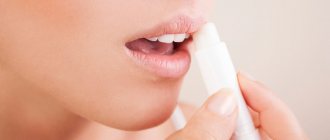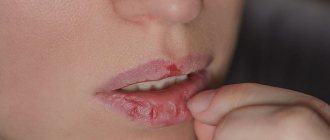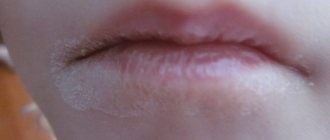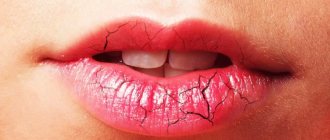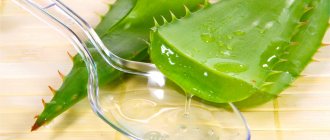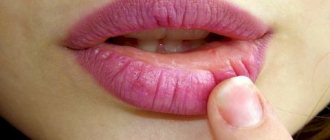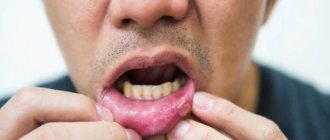Dermatovenerologist
Khasanova
Alina Rashidovna
9 years experience
Make an appointment
Patients often consult a doctor complaining of inflammation in the red border or mucous membrane of the lips. In most cases, a specialist diagnoses “cheilitis”. This is the name for tissue inflammation, which manifests itself in the form of redness, peeling, the appearance of purulent crusts and weeping ulcers. Any attempt to open the mouth when eating or communicating causes sharp pain associated with tissue damage. Without proper treatment, the disease persists for a long time, causing the patient a lot of physical and aesthetic inconvenience. For young people, the prognosis after clinical treatment of cheilitis is completely favorable, but older patients may encounter its complications in the form of leukoplakia and the onset of the oncological process.
Reasons for development
In the clinical practice of most specialists, there are cases where cheilitis on the lips developed on its own or was a side effect of a serious disease of the internal organs or damage to the mucous membrane. Among the most likely causes of the development of the disease are:
- inflammation of the mucous membrane with dermatoses, erythematoses or lichen planus;
- infectious diseases: syphilis, tuberculosis, etc.;
- psoriasis and other skin problems.
Among the unfavorable external factors, it is worth noting an excessive amount of ultraviolet radiation, strong wind, flows of cold or hot air from climate control equipment or ventilation in industrial premises. Signs of cheilitis are often observed in people who work in open areas in direct sunlight.
A separate group includes manifestations of allergic cheilitis, which developed after contact of the lip mucosa with aggressive chemicals or prolonged exposure to ultraviolet radiation. Sometimes doctors observe the clinical picture of secondary cheilitis, when the development of the disease is caused by eczema, neuritis of the facial nerve, pathologies of the muscles and tissues of the facial part of the skull.
Meteorological cheilitis
Meteorological cheilitis is an inflammatory disease of the lips, the development of which is caused by a variety of meteorological factors (high or low humidity, dusty air, strong winds, low temperatures, sun rays, etc.).
The duration of exposure to these factors and the constitutional characteristics of the skin play an important role: cheilitis most often occurs either in people with white and delicate skin, or with skin diseases accompanied by increased dryness.
The disease can develop at any time of the year. Mostly affected are people whose work involves prolonged exposure to the fresh air, as well as people leading an active lifestyle in the fresh air. The disease often occurs in men, since the use of lipstick by women has a protective function.
Symptoms:
Most often, the pathological process affects the red border of the lower lip. The whole area becomes brighter in color than the top one and swells a little. The skin in this area becomes dry and a large number of small scales appear on it. When visiting a doctor, the patient complains to the doctor about the feeling of dryness of the affected lip, and sometimes there is a peculiar feeling of “tightening” of the skin. Patients, as a rule, constantly lick their lips, which leads to a worsening of the condition - long-term non-healing cracks appear, at risk of secondary infection.
Treatment:
A necessary condition for achieving recovery is the complete or at least partial elimination of the effects of all negative environmental factors on the skin. Sometimes this can be quite difficult to do. Among medications, vitamin preparations are primarily prescribed: A, E, C, B, PP.
Some patients, due to increased nervous excitability, can tear off the scales, as a result of which the lips bleed, and long-term non-healing cracks begin to form on their surface. In this case, mild sedatives are prescribed (tincture of valerian, motherwort), it is recommended to undergo a course of vitamin therapy with an emphasis on B vitamins. And constantly use hygienic lipstick, especially when leaving the house outside. Currently, there are also a large number of photoprotective creams and ointments.
Prevention:
Apply protective lipstick or sunscreen to your lips every time you go outside. If possible, it is necessary to transfer to another job that does not involve constant exposure to the open air. Stick to a nutritious, fortified diet.
Symptoms and signs depending on the type of cheilitis
The accepted classification of cheilitis makes it possible to clearly establish the type and causes of the disease, as well as to identify the characteristic signs of the pathological process:
- Exfoliative cheilitis is localized on the red border of the lips. It has a clear gender link: it occurs more often in women. The main symptom is peeling of the lips due to neurological disorders: stress, depression, anxiety. Often the inflammatory process develops against the background of hyperthyroidism, or intense activity of the thyroid gland. The danger of exfoliative cheilitis is its ability to be inherited as a genetically fixed change in the body’s immune system.
A feature of exfoliative cheilitis is localization only on the red border of the lips, while the mucous membrane and skin around the mouth remain intact. In most cases, only part of the border is affected, while areas at the corners of the mouth usually retain their appearance. If a patient has dry skin, he often complains of tightness of the lips, the appearance of scales, and a burning sensation. It is almost impossible to completely cure exfoliative cheilitis. The disease proceeds along a sinusoid, sometimes exacerbating, sometimes disappearing under the influence of medications and external factors. Without medical supervision and if you refuse to take a course of treatment, large bleeding crusts form on the lips, which cause discomfort during conversation and eating.
- Glandular cheilitis develops against the background of pathological proliferation of the salivary glands. A humid environment creates favorable conditions for pathogenic microorganisms, as a result of which the mucous membrane becomes easily infected. If the pathology of the salivary glands is congenital, the probability of developing glandular cheilitis is 100%. The risk group also includes patients with dental problems: untreated caries, periodontitis, tartar, etc.
In some cases, glandular cheilitis develops as a result of damage from waste products and the breakdown of pathogenic microorganisms. The disease is more often diagnosed in patients over 30 years of age and is localized on the lower lip. Primary symptoms are dry lips and the appearance of painful cracks. Usually these symptoms are ignored, and attempts are made to combat them with local cosmetic products. Without treatment, the problem worsens: erosions and bleeding wounds appear at the site of cracks. Involuntary licking of dry lips aggravates the pathological process, which leads to their further dryness.
- Contact allergic cheilitis is caused by exposure to an external allergen. This could be the chemical composition of lipstick, microorganisms on the surface of pencils or pens, which the patient is accustomed to often holding in his teeth during work or creative activities. Cheilitis is considered an occupational disease among musicians who are forced to hold the mouthpieces of instruments in their mouths for a long time. The symptoms of this type of pathology are quite common. Patients complain of itching, swelling, burning and inflammation of the lips. After prolonged contact with the allergen, blisters appear on the skin, the rupture of which opens small ulcers and erosions. In the chronic stage, the disease makes itself felt only with minor itching and peeling.
- Meteorological or actinic cheilitis is a reaction to weather conditions. For a sensitive organism, radiation, wind, cold or solar radiation are equally dangerous, provoking the appearance of characteristic symptoms: burning and itching, large crusts and erosion of the mucous membrane. With prolonged exposure to unfavorable climatic factors, the formation of small bubbles with liquid contents is possible. The dry form of cheilitis is considered the most dangerous for patients. Its first symptoms in the form of itching and burning are harmless. However, with prolonged development and lack of treatment, malignancy is possible - the degeneration of affected cells into a malignant formation.
- Atopic cheilitis is a type of skin disease: atopic dermatitis and neurodermatitis. The disease develops against the background of an allergic predisposition of the body, which reacts to cosmetics, perfumes, food and exposure to pathogenic bacteria. In addition to the usual symptoms, there is dryness and damage to the skin in the corners of the mouth, and intense peeling of the face.
- Hypovitaminous cheilitis develops against the background of a lack of B vitamins in the body. Patients usually complain of dryness and burning of the tongue and lips. Vertical cracks and small peeling scales are visible on the skin. The tongue increases in size, and teeth marks become visible on it.
Are you experiencing symptoms of cheilitis?
Only a doctor can accurately diagnose the disease. Don't delay your consultation - call
Treatment of exfoliative cheilitis
Treatment of exfoliative cheilitis involves, first of all, influencing the factors that provoked it. Since cheilitis is one of the diseases associated with the patient’s psycho-emotional state, a consultation with a neurologist is often required, who can prescribe sedatives or antidepressants. If the disease occurs due to thyroid dysfunction, you will need to consult an endocrinologist.
Treatment may also include acupuncture, removal of keratinized crusts on the lips with a solution of boric acid, and in children, the use of a moisturizer.
The disease is not prone to self-healing, so it is necessary to find the cause of the disease and carry out all treatment measures in a timely manner.
Treatment of various types of cheilitis
The course is developed taking into account the type of diagnosed disease and the general condition of the body.
- For exfoliative cheilitis, additional consultations with a neurologist and neuropsychiatrist are recommended. The patient is prescribed a course of sedatives. Effective methods of local treatment include laser therapy, ultrasound or radiation therapy, and the use of moisturizing cosmetic creams and ointments. According to indications, hormonal medications and vitamin complexes are prescribed.
- Glandular cheilitis is removed with anti-inflammatory ointments. Local treatment consists of cauterization or desquamation of enlarged salivary glands, and during the rehabilitation period, the use of drugs to eliminate dryness or excess moisture of the mucous membrane.
- When treating atopic cheilitis, the goal is to eliminate any irritating factors. The local course is based on the use of anti-inflammatory and anti-allergic drugs in the form of external ointments. Patients are also recommended to have a hypoallergenic diet that excludes the consumption of fish, citrus fruits, spicy foods and alcohol.
- For meteorological cheilitis, treatment tactics include taking vitamin preparations, using local healing agents and ointments with a high UV filter.
Timely initiation of treatment and the patient completing its full course guarantees relief from the unpleasant symptoms of cheilitis with a long-term effect.
Diagnosis and treatment of cheilitis
The process of diagnosing a disease includes, first of all, the collection of patient complaints and a careful external examination by a dermatologist. Despite its apparent simplicity, this procedure is very important, since it allows one to differentiate meteorological cheilitis from other types of pathology - and, therefore, use a more effective treatment method.
The main goal of treatment is to eliminate harmful factors influencing the development of the disease. Sometimes, if possible, it is recommended to either change work in open spaces or use protective equipment more intensively. The next step in the treatment process is the use of products with regenerating properties: hygienic medicated lipsticks (best purchased in pharmacies), as well as preparations containing vitamin E. In some cases, vitamin capsules or liquid vitamin E are also used.
In the presence of local inflammation, it is recommended to use regenerating ointments and a solution of vitamin A. If, due to nervousness, the patient develops the habit of tearing off or biting off pieces of skin from the lips, he is prescribed various medications with sedative properties. Prevention of the disease includes taking a course of vitamins at least twice a year.
Timely and high-quality treatment reduces the risk of relapse to almost zero. If this was not provided, there is a risk of developing secondary infections up to a precancerous condition.
Prevention of cheilitis
Consists of the following items:
- strengthening immunity, maintaining a healthy lifestyle
- use of creams and lipsticks with SPF
- use of hygienic lipsticks
- balanced diet
- regular visits to the dentist
- proper teeth cleaning at home, as well as professional removal of dental plaque in the dentist’s chair
- avoiding contact with allergens
- undergoing an annual medical examination to identify common diseases
- treatment of systemic diseases
- Antibacterial drugs should be taken exclusively as prescribed by a doctor and in conjunction with a course of probiotics
Is cheilitis treated surgically?
Yes, some forms require surgical treatment (Mischer cheilitis, glandular cheilitis, chronic fissure), but most cheilitis is treated conservatively.
How do you know if you are deficient in B vitamins?
Signs of a lack of B vitamins are fatigue, insomnia, muscle pain, dry mouth, seizures, peeling facial skin, brittle nails, fainting, and memory problems. The surest way is to take a comprehensive vitamin test.
Solution
Treatment of glandular cheilitis involves both local drug therapy and surgery, as well as systemic measures aimed at combating pathological changes in the structure of the salivary glands.
Inflammation of the oral mucosa
So, patients are prescribed:
- local anti-inflammatory drugs (prednisolone and syntomycin ointments);
- enzyme preparations (lysozyme, trypsin);
- reparative medicines (adhesive pastes, dexpanthenol).
Comprehensive treatment of HC involves complete cessation of smoking and high-quality oral care. Due to the dental nature of the disease, treatment of primary problems with teeth and gums is required. To improve the general well-being of patients suffering from chronic HC, tranquilizers and sedatives (Phenazepam, valerian tincture), vascular medications (Vinpocetine) are used, and suitable vitamin and mineral complexes are selected.
Important! If a patient is diagnosed with a purulent form of HC, he is advised to take broad-spectrum antibacterial drugs.
Surgical treatment of the disease involves electrocoagulation of the affected salivary glands. When a large amount of hypertrophied glandular tissue is present, the gland is removed completely. The operation includes the following steps:
- the dental surgeon administers local infiltration anesthesia;
- then dissects the salivary gland along the Klein line;
- excises overgrown areas of tissue;
- sutures with catgut threads.
The course of purulent cheilitis is accompanied by the appearance of multiple dry crusts on the lips
How the problem manifests itself
HC “announces itself” with classic symptoms - characteristic red dots appear on the border of the lips (seen in the photo above). These are nothing more than the mouths of the salivary glands affected by the disease. If you blot your lips, after a short period of time droplets of secretion will appear on them again. Due to the fact that saliva is produced in excess of normal, the surface of the lips is constantly moisturized. But due to the constant evaporation of liquid, the skin, accustomed to “humidity,” cracks and flakes.
Secondary GC is a complication of skin diseases, pathological processes in the oral cavity, the result of smoking and neglect of the rules of caring for teeth and gums
In some patients, the course of HC is associated with constant itching in the affected area. At the same time, the “affected” skin looks rough, unhealthy, the epithelium becomes keratinized and dry. White ring-shaped formations often appear around the mouths of the salivary glands - these are foci of leukoplakia. The purulent form of cheilitis most typically manifests itself. Thus, the lips swell, become extremely sensitive to any mechanical damage, and are very painful.
On examination, the skin looks red, swollen, thinned, flaky, the epithelium is covered with multiple purulent crusts. Upon palpation, enlarged, compacted salivary glands are determined, when pressed, a secretion mixed with purulent exudate is released. In the complicated course of Volkmann's cheilitis, local signs of inflammation are accompanied by symptoms of general intoxication of the body, enlargement of the submandibular lymph nodes, and abscess formation of the lips.


